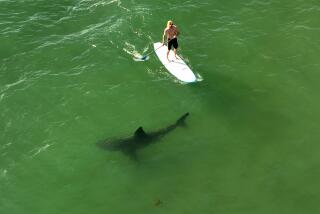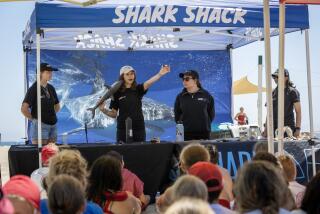Reel Deal
DANA POINT â Capt. Jay Bush trained his acute vision on the horizon ahead, where the navy blue Pacific met the pale blue sky. His weathered features focused on a mix of sea birds that stirred on the surface, while others circled slightly above.
Slicing between this commotion were a dozen porpoises, which dipped in and out of the shifting sea.
Bush wasnât interested in this watery scene, but rather the large ball of anchovies and sardines gliding beneath the surface. With a single cry of âBait,â Bush spun the eyes of his three-man crew toward movement off the bow of his 46-foot vessel.
Just as quickly, the men turned their attention toward the fish meter mounted on the console where a large, shaded outline moved across the 18-inch screen. âThatâs what weâre looking for, right there,â Bush yelled as he circled the silhouette with his index finger.
It was an ideal start for this particular outing. Bush and his mates were looking for thresher sharks and, as any seasoned angler knows, locating their food source is the key to finding these predators.
Bush, 43, has been running charters out of Dana Point Harbor about 10 years. After five years as operator of the 46 Bertram Sportfisher named âStimulator,â he became owner last year.
Pursuing threshers off the local coastline is not a full-time adventure for Bush, because itâs not often these fish wander into waters off Orange County. More likely heâs taking patrons out looking for yellowtail, bass or barracuda off Catalina and San Clemente islands, or venturing south past Coronado Island and into Mexican waters for tuna and other big game fish. He also takes customers spearfishing, scuba diving, or sight-seeing.
But for approximately 10 weeks of the year, in late spring and early summer, Bush pursues the threshers, one of the gamest fish that ever moves through this area.
This species of shark is unlike any other. It is easily identified by its distinctively long tail, which is nearly as long as its body. The tail is the sharkâs most potent weapon, used to stun and kill prey with a swift flick. Its small mouth then swallows up the lifeless bait and its tiny teeth do the rest.
This tail also makes it exciting to catch. No other sea creature is hooked in the tail as often as the thresher, which gives this shark an advantage. With its frontside unimpeded, the thresher is able to generate substantial propulsion in its escape attempt, thus providing a better fight for the angler.
Its delectable white meat and lack of bones also make it quite a trophy for the dinner table.
While Bush kept his eye on the fish meter, his friends, Mark Washburn and Dave Aulrich, began to rig up. The tackle used for threshers needs to be stout. The most popular rig for those after sharks is a PENN 50SW or 80SW International with a two-speed reel loaded with high quality, 80-pound Dacron line.
Bush and his crew know they canât afford to skimp on the tackle, because anyone who hooks into a thresher probably will be wired for hours. He has seen what an average-sized shark can do to undersized line, snapping it before the real fight even begins.
Having enough tackle on the reel is just as important, Bush emphasizes. The water a few miles off Southern Californiaâs coast is usually more than 1,000 feet deep, and the thresherâs first instinct once hooked is to dive straight down. Getting spooled is always a major concern when sharkfishing.
Washburn nearly lost a thresher during a tournament last year after it continued to run, and it would have cost him $20,000 in first-place money.
âA couple of times during the fight I could see the silver of my reel showing through,â he said. âI had my backup rod ready to go if I needed to throw the other one overboard.â
Such a tactic is not easy to do in that situation. If the fish breaks loose, a rod and reel that costs hundreds of dollars is lost as well.
Many individuals would like to see threshers, as well as other species, get away more often. Overfishing of sharks in general has become a serious problem for a number of reasons.
Sharks are not like bony fish, which can release between one million and 100 million eggs in a single spawning. They are at the top of the food chain in the ocean, so nature has ensured their numbers remain balanced by equipping them with slow reproductive cycles.
Most sharks mate only once a year, and then have only one to two offspring, and many give birth to live offspring after a gestation period of approximately one year.
Much of the demise is attributed to commercial fishermen who kill sharks for their fins, which are a delicacy used for soup primarily in Asian countries. In Asia, fins go for approximately $150 a pound, and in the United States they cost $5 to $30 a pound.
American fisherman in U.S. waters are prohibited by law from practicing finning, and legislation protecting sharks from finning, as well as protecting sharks in general, is slowly being passed by countries around the world.
âSharkfin soup is a high-class meal in the Orient, but in recent years the economy has allowed the middle class to afford these items as well,â said George H. Burgess, senior biologist in ichthyology at the Florida Museum of Natural History. âThis has created even more of a strain on the shark population around the world.â
Bush, who tags and releases nearly every shark he catches, has seen another threat in local tournaments that have become popular in recent years. He said contestants will typically keep any sharks in the 60- to 80-pound range for a possible jackpot. Because most donât reach full maturity until they grow to 100 pounds, this eliminates any possibility of reproducing.
âTen years ago, you used to be able to come out here at 3 in the afternoon, and by 6 you would have caught three or four makos,â Bush said. âNow you might hook up with a thresher every seventh or eighth trip and a mako every two or three.â
Bush has seen how regulating catches can help bring back endangered fish. Several years ago, black and white sea bass were on the verge of extinction, but laws were passed to raise the length of keepers, limits were decreased and their brood stock was caught and placed in breeding programs.
âItâs working, theyâre coming back,â Bush said. âItâs taken 10 or 11 years, but itâs turning around.â
After nearly 10 hours of trolling, drifting and chumming, it looks like this day might be one of those empty-handed outings. Bush and his comrades gave it everything they had, but itâs obvious there are no sharks in the area on this particular day.
âWe opted to go for all or nothing,â Bush said. âWe couldâve put out a slick and easily caught some blue sharks, but thatâs why we call this fishing and not catching.â
For more information on Stimulator Sportfishing charters call (714) 240-7226 or access its Web site at https://www.skipnout.com
More to Read
Sign up for Essential California
The most important California stories and recommendations in your inbox every morning.
You may occasionally receive promotional content from the Los Angeles Times.










